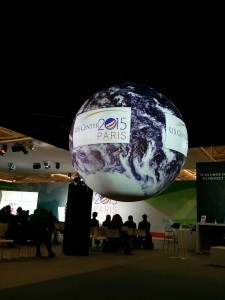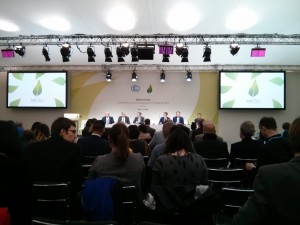Technology ultimately plays a large role in the actual, physical mitigation and adaptation plans established by different parties and organizations. However, it should be noted much of the discussion of “technology” that goes on in the COP21 is pretty far removed from the actual science. Many bodies of scientific experts such as the SBSTA that are part of the COP simply compile and submit relevant recommendations for the COP to consider and can only influence the negotiations indirectly. Policy initiatives and mechanisms that integrate technology and are designed to aid for instance, Least Developed Countries (LDCs) and Small Island Developing States (SIDS), seem to be largely set up to provide “technical assistance” or “capacity-building” and act as networks that connect these government entities with other firms that are concentrated bodies of expertise.

During one of the side events I sat in on, I found that the Climate Technology Center & Network (CTCN) is exactly that, and is coincidentally recognized as the operational arm of the COP21 in this regard in conjunction with Technology Executive Committee (TEC) which is the policy recommendation arm. Through the CTCN, no finance is provided for projects nor actual technological solutions, but simply feasibility studies and other “requests” for technical assistance which governments who need the help must actually formally submit for through Nationally Designated Entities (NDEs) defined by the requesting country and then pay up to hundreds of thousands of USD ($100,000-200,000) for the services. Arguably, these countries can seek funding from other sources to pay for these services, but it brings to mind questions about whether technology is really being effectively implemented in this way given their already limited resources. If this is the process that a developing country must go through in order to simply identify which technologies to implement, I fear how the combined lag of international policy bodies to make decisions, these intermediate phases of technological development, and the actual implementation of technologies will affect our ability to cope with climate change when our preparation time is already in short supply.

Hi Dakota,
I’m glad to see you following the money when it comes to technology. What is a SIDS (when it’s not sudden infant death syndrome)? Small Island Developing State?
Is this the process you’re describing?
Let’s say I’m a small island nation (SIDS?) and I want to know how long we might be able to hold the sea at bay using technology developed by Holland. I create an NDE (nationally designated entity) and then I use that NDE to request a feasibility study from CTCN, but I (or my NDE) have to pay CTCN hundreds of thousands of dollars for that study. Is there significant benefit to using the CTCN? Or would I do as well to have one of my advisors go and consult directly with experts in Holland?
How can the CTCN be the operational arm if it doesn’t actually operationalize anything? (That’s your point, right?) Does the TEC actually make any policy recommendations? What policy recommendations has it made, and to whom?
Hi Betsy!
I updated my post in response to your questions, SIDS are indeed small island developing states. And yes, from what I observed, this is essentially the process that you might see from the CTCN although I think instead of looking for technology developed by a specific country, most requests are simply made by first characterizing a problem that the requester may need and then the CTCN will act to match or develop the corresponding “assistance” to the requester.
The significant benefit of using the CTCN is the network power it has as a UN-designated body. By being backed by the UN, it has legitimacy, visibility, and presumably the funding to attract a lot of members. I discovered after the meeting that the CTCN mainly relies on its base of members (membership is free) to provide a large majority of its services which are usually nationally or regionally recognized technology institutions from pretty much any background (NGO, academic, financial, etc).
And finally, yea that is essentially what I was trying to hint at. I feel that all of the “operational modalities” and bodies discussed at the COP have very tenuously defined roles, which is no doubt the result of the COP being such an amorphous event itself. As for the TEC, it does make policy recommendations to the COP and its parties, and these vary based on the topic it is covering. So far the TEC has made policy recommendations/ written briefs on distributed renewable energy, national innovation to enhance actions, climate technology financing, adaptation for the agricultural sector, technology for adaptation in the water sector, technology roadmapping, and technology needs assessments.
Thanks, Dakota. This is very helpful.
(For anyone else interested, I googled UNFCCC TEC and got to TT: CLEAR where I found the briefs. This one on climate technology financing was actually fairly accessible:
http://unfccc.int/ttclear/misc_/StaticFiles/gnwoerk_static/TEC_documents/204f400573e647299c1a7971feec7ace/ea65db0ca9264cdbaefeb272dd30b34c.pdf)
I wouldn’t have known to go and look without your post and your subsequent guidance. Thanks!
In this article it says the CTCN does not finance projects or technological solutions, Why do you think they do not provide financial support?